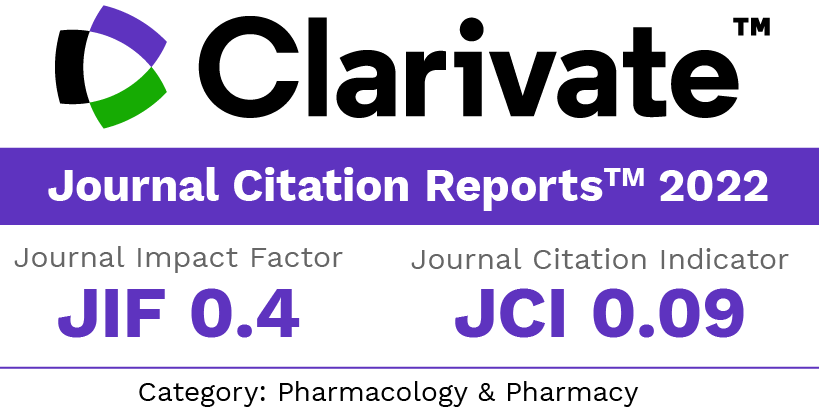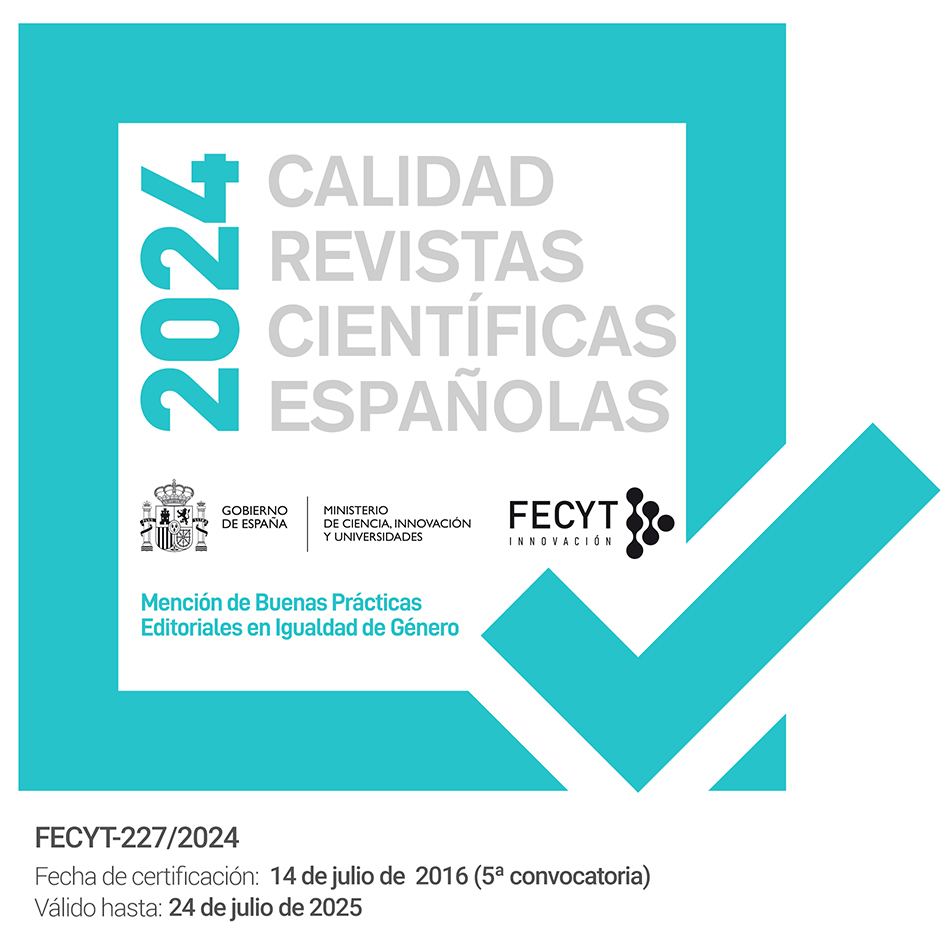Bioactividad de la umbelliprenina, principal componente de las semillas de Angelica sylvestris
Palabras clave:
Angelica sylvestris, Apiaceae, Actividad antioxidante, Actividad antibacteriana, Bioensayo de letalidad de gambas en salmueraResumen
Se ha evaluado la actividad antibacteriana y antioxidante de la umbelliprenina (1), una cumarina desesquiterpenil, aislada como el componente principal presente en extractos de n-hexano y diclorometanode semillas de Angelica sylvestris (Apiaceae). También se ha evaluado la toxicidad general de 1 medianteel bioensayo de letalidad de gambas en salmuera (BSL).Descargas
Citas
Clapham AR, Tutin TG and Warburg EF. Flora of the British Isles. 1952. Cambridge University Press, UK.
USDA-ARS-GRIN Database. USDA, ARS, National Genetic Resources Program, Germplasm Resources Information
Network - (GRIN), National Germplasm Resources Laboratory, Beltsville, Maryland, USA. 2004. Available on-line at http://www.ars-grin.gov/cgi-bin/npgs/html/taxon.pl?3425
Howard M. Traditional Folk remedies Comprehensive Herbal. 1987. London: Century Hutchinson Ltd.
Sarker SD and Nahar L. Natural medicine: the genus Angelica. Current Medicinal Chemistry 2004. 11: 1479-1500.
Potterton D. Couplers’ Colour Herbal. 1997. Cippenham: Foulsham Publishing.
Sarker SD, Eynon E, Fok K, Kumarasamy Y, Murphy EM, Nahar L, Shaheen EM, Shaw NM and Siakalima M. Screening the extracts of the seeds of Achillea millefolium, Angelica sylvestris and Phleum pratense for antibacterial, antioxidant activities and general toxicity. Oriental Pharmacy and Experimental Medicine. 2003. 3: 157-162.
Murphy EM, Nahar L, Byres M, Shoeb M, Siakalima M, Rahman MM, Gray AI and Sarker, SD. Coumarins from the seeds of Angelica sylvestris (Apiaceae) and their distribution within the genus Angelica. Biochem. Syst. Ecol. 2004. 32, 203-207.
Kumarasamy Y, Nahar L, Byres M, Delazar A and Sarker, SD. Assessment of biological activities associated with the major constituents of the methanol extract of ‘wild carrot’ (Daucus carota L.) seeds. J. Herbal Pharmacotherapy. 2005.
in press).
Rahman MM, Sarker SD, Byres M and Gray AI. New salicylic acid and isoflavone derivatives from Flemingia paniculata. J. Nat. Prod. 2004. 67: 402-406.
Delazar A, Byres M, Gibbons S, Kumarasamy Y, Nahar L, Modarresi M, Shoeb M and Sarker SD. Iridoid glycosides from Eromostachys glabra. J. Nat. Prod. 2004. 67: 1584-1587
Datta BK, Datta SK, Chowdhury MM, Khan TH, Kundu JK, Rashid MA, Nahar L and Sarker SD. Analgesic, antiinflammatory and CNS depressant activities of sesquiterpenes and a flavonoid glycoside from Polygonum viscosum. Die Pharmazie. 2004. 59: 222-225.
Shoeb M, Rahman MM, Nahar L, Jaspars M, MacManus S, Delazar A and Sarker SD. Bioactive lignans from the seeds of Centaurea macrocephala. DARU. 2004. 12:87-93.
Kumarasamy Y, Byres M, Cox PJ, Delazar A, Jaspars M, Nahar L, Shoeb M and Sarker, SD. Isolation, structure elucidation and biological activity of flavone C-glycosides from the seeds of Alliaria petiolata. Chemistry of Natural Compounds. 2004. 40: 122-128.
Haque ME, Haque M, Rahman MM, Rahman MM, Khondkar P, Wahed MII, Mossadik MA, Gray AI and Sarker SD. E-Octadec-8-en-5-ynoic acid from the roots of Capparis zeylanica. Fitoterapia. 2004. 75: 130-133.
Sarker SD, Kumarasamy Y and Nahar L. Insect sex pheromone type alkenes from the seeds of Quercus robur (Fagaceae).
Chemistry of Natural Compounds. 2004. 40: 286-288.
Datta BK, Khan TH, Kundu JK, Rashid MA, Datta SK, Nahar L and Sarker SD. Anti-cholinergic, cytotoxic and anti-HIV-1 activities of sesquiterpenes and a flavonoid from Polygonum viscosum. Pharm. Biol. 2004. 42: 18-23.
Uddin SJ, Shilpi JA, Delazar A, Nahar L and Sarker SD. Free radical scavenging activity of some Bangladeshi plant extracts. Oriental Pharmacy and Experimental Medicine. 2004. 4: 185-193.
Takao T, Watanabe N, Yagi I and Sakata K. A simple screening method for antioxidants and isolation of several antioxidants produced by marine-bacteria from fish and shellfish. Biosci. Biotech.Biochem. 1994. 58: 1780-1783.
Meyer BN, Ferrigni NR, Putnam JE, Jacobson LB, Nicholas DE, McLaughlin JL. Brine shrimp - a convenient general bioassay for active-plant constituents. Planta Medica. 1982. 45:31-34.
Finney DJ. Probit Analysis, 3rd edn, Cambridge University Press Cambridge. (1971).
Dadak V, Hodak K. Some relations between the structure and the antibacterial activity of natural coumarins. Experientia. 1966. 22:38-39.
Zboril P, Holasova J, Dadak V. Antibiotic efficiency of natural coumarins. X. Mode of action of phenolic derivatives of coumarin on succinate oxidase in the Keilin-Hartree preparation. Collection of Czechoslovak Chemical Communications. 1970. 35: 2983-2995.
Ngwendson JN, Badir E, Efange SMN, Okunji CO, Iwu MM, Schuster BG, Khan IA. Constituents of Peucedanum zenkeri seeds and their antimicrobial effects. Die Pharmazie. 2003. 58: 587-589.
Iranshahi M, Shahverdi AR, Mirjani R, Amin G, Shafiee A. Umbelliprenin from Ferula persica roots inhibits the red pigment production in Serratia marcescens. Journal of Bioscience. 2004. 59: 506-508.
Descargas
Publicado
Cómo citar
Número
Sección
Licencia
Los artículos que se publican en esta revista están sujetos a los siguientes términos en relación a los derechos patrimoniales o de explotación:
- Los autores/as conservarán sus derechos de autor y garantizarán a la revista el derecho de primera publicación de su obra, la cual se distribuirá con una licencia Creative Commons BY-NC-SA 4.0 que permite a terceros reutilizar la obra siempre que se indique su autor, se cite la fuente original y no se haga un uso comercial de la misma.
- Los autores/as podrán adoptar otros acuerdos de licencia no exclusiva de distribución de la versión de la obra publicada (p. ej.: depositarla en un archivo telemático institucional o publicarla en un volumen monográfico) siempre que se indique la fuente original de su publicación.
- Se permite y recomienda a los autores/as difundir su obra a través de Internet (p. ej.: en repositorios institucionales o en su página web) antes y durante el proceso de envío, lo cual puede producir intercambios interesantes y aumentar las citas de la obra publicada. (Véase El efecto del acceso abierto).



















